geom_rect() and geom_tile() do the same thing, but are
parameterised differently: geom_tile() uses the center of the tile and its
size (x, y, width, height), while geom_rect() can use those or the
locations of the corners (xmin, xmax, ymin and ymax).
geom_raster() is a high performance special case for when all the tiles
are the same size, and no pattern fills are applied.
Usage
geom_raster(
mapping = NULL,
data = NULL,
stat = "identity",
position = "identity",
...,
interpolate = FALSE,
hjust = 0.5,
vjust = 0.5,
na.rm = FALSE,
show.legend = NA,
inherit.aes = TRUE
)
geom_rect(
mapping = NULL,
data = NULL,
stat = "identity",
position = "identity",
...,
lineend = "butt",
linejoin = "mitre",
na.rm = FALSE,
show.legend = NA,
inherit.aes = TRUE
)
geom_tile(
mapping = NULL,
data = NULL,
stat = "identity",
position = "identity",
...,
lineend = "butt",
linejoin = "mitre",
na.rm = FALSE,
show.legend = NA,
inherit.aes = TRUE
)Arguments
- mapping
Set of aesthetic mappings created by
aes(). If specified andinherit.aes = TRUE(the default), it is combined with the default mapping at the top level of the plot. You must supplymappingif there is no plot mapping.- data
The data to be displayed in this layer. There are three options:
NULL(default): the data is inherited from the plot data as specified in the call toggplot().A
data.frame, or other object, will override the plot data. All objects will be fortified to produce a data frame. Seefortify()for which variables will be created.A
functionwill be called with a single argument, the plot data. The return value must be adata.frame, and will be used as the layer data. Afunctioncan be created from aformula(e.g.~ head(.x, 10)).
- stat
The statistical transformation to use on the data for this layer. When using a
geom_*()function to construct a layer, thestatargument can be used to override the default coupling between geoms and stats. Thestatargument accepts the following:A
Statggproto subclass, for exampleStatCount.A string naming the stat. To give the stat as a string, strip the function name of the
stat_prefix. For example, to usestat_count(), give the stat as"count".For more information and other ways to specify the stat, see the layer stat documentation.
- position
A position adjustment to use on the data for this layer. This can be used in various ways, including to prevent overplotting and improving the display. The
positionargument accepts the following:The result of calling a position function, such as
position_jitter(). This method allows for passing extra arguments to the position.A string naming the position adjustment. To give the position as a string, strip the function name of the
position_prefix. For example, to useposition_jitter(), give the position as"jitter".For more information and other ways to specify the position, see the layer position documentation.
- ...
Other arguments passed on to
layer()'sparamsargument. These arguments broadly fall into one of 4 categories below. Notably, further arguments to thepositionargument, or aesthetics that are required can not be passed through.... Unknown arguments that are not part of the 4 categories below are ignored.Static aesthetics that are not mapped to a scale, but are at a fixed value and apply to the layer as a whole. For example,
colour = "red"orlinewidth = 3. The geom's documentation has an Aesthetics section that lists the available options. The 'required' aesthetics cannot be passed on to theparams. Please note that while passing unmapped aesthetics as vectors is technically possible, the order and required length is not guaranteed to be parallel to the input data.When constructing a layer using a
stat_*()function, the...argument can be used to pass on parameters to thegeompart of the layer. An example of this isstat_density(geom = "area", outline.type = "both"). The geom's documentation lists which parameters it can accept.Inversely, when constructing a layer using a
geom_*()function, the...argument can be used to pass on parameters to thestatpart of the layer. An example of this isgeom_area(stat = "density", adjust = 0.5). The stat's documentation lists which parameters it can accept.The
key_glyphargument oflayer()may also be passed on through.... This can be one of the functions described as key glyphs, to change the display of the layer in the legend.
- interpolate
If
TRUEinterpolate linearly, ifFALSE(the default) don't interpolate.- hjust, vjust
horizontal and vertical justification of the grob. Each justification value should be a number between 0 and 1. Defaults to 0.5 for both, centering each pixel over its data location.
- na.rm
If
FALSE, the default, missing values are removed with a warning. IfTRUE, missing values are silently removed.- show.legend
Logical. Should this layer be included in the legends?
NA, the default, includes if any aesthetics are mapped.FALSEnever includes, andTRUEalways includes. It can also be a named logical vector to finely select the aesthetics to display. To include legend keys for all levels, even when no data exists, useTRUE. IfNA, all levels are shown in legend, but unobserved levels are omitted.- inherit.aes
If
FALSE, overrides the default aesthetics, rather than combining with them. This is most useful for helper functions that define both data and aesthetics and shouldn't inherit behaviour from the default plot specification, e.g.annotation_borders().- lineend
Line end style, one of
"round","butt"or"square".- linejoin
Line join style, one of
"round","mitre"or"bevel".
Details
Please note that the width and height aesthetics are not true position
aesthetics and therefore are not subject to scale transformation. It is
only after transformation that these aesthetics are applied.
Aesthetics
geom_rect() understands the following aesthetics. Required aesthetics are displayed in bold and defaults are displayed for optional aesthetics:
| • | x or width or xmin or xmax | |
| • | y or height or ymin or ymax | |
| • | alpha | → NA |
| • | colour | → via theme() |
| • | fill | → via theme() |
| • | group | → inferred |
| • | linetype | → via theme() |
| • | linewidth | → via theme() |
geom_tile() understands only the x/width and y/height combinations.
Note that geom_raster() ignores colour.
Learn more about setting these aesthetics in vignette("ggplot2-specs").
Examples
# The most common use for rectangles is to draw a surface. You always want
# to use geom_raster here because it's so much faster, and produces
# smaller output when saving to PDF
ggplot(faithfuld, aes(waiting, eruptions)) +
geom_raster(aes(fill = density))
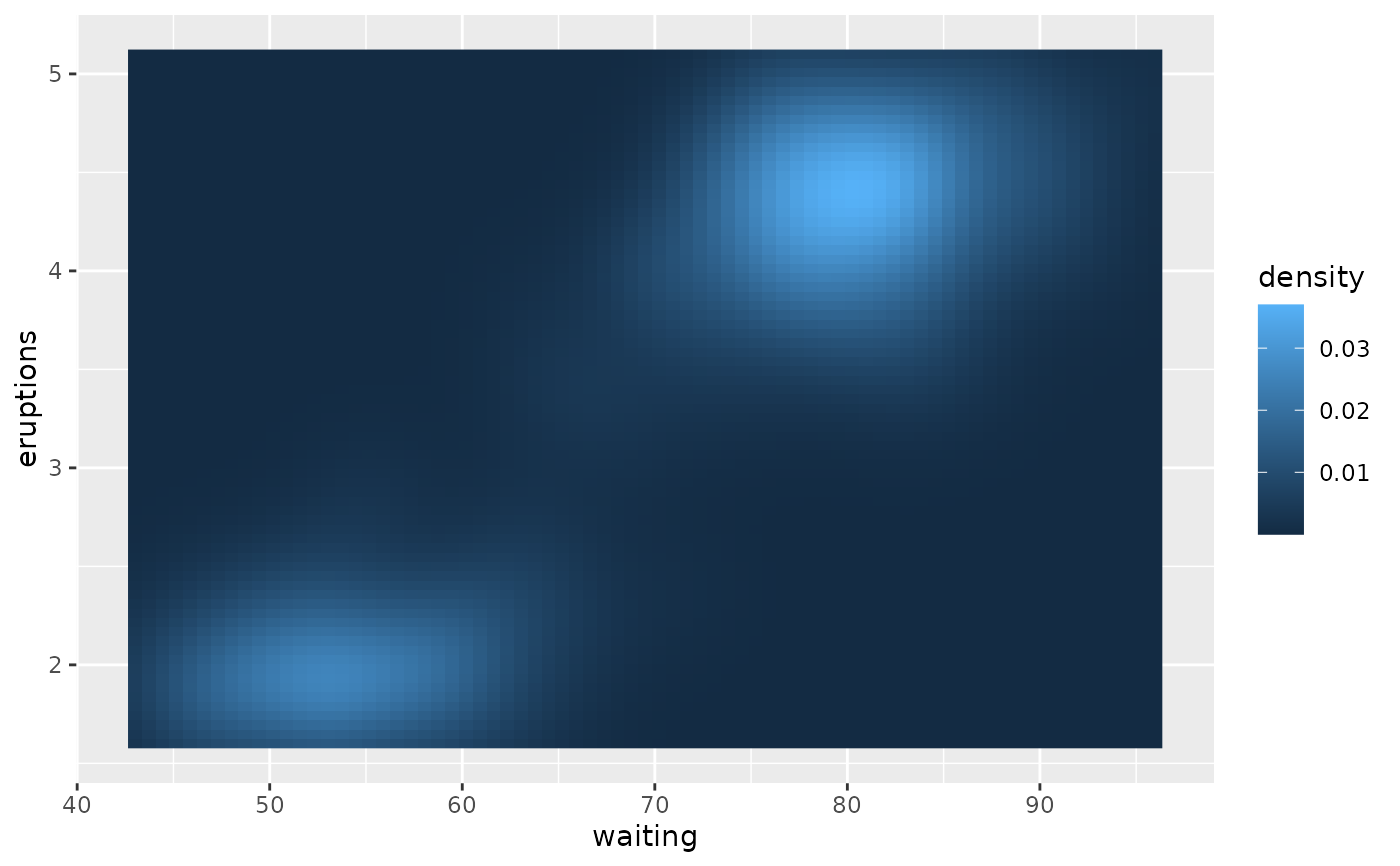 # Interpolation smooths the surface & is most helpful when rendering images.
ggplot(faithfuld, aes(waiting, eruptions)) +
geom_raster(aes(fill = density), interpolate = TRUE)
# Interpolation smooths the surface & is most helpful when rendering images.
ggplot(faithfuld, aes(waiting, eruptions)) +
geom_raster(aes(fill = density), interpolate = TRUE)
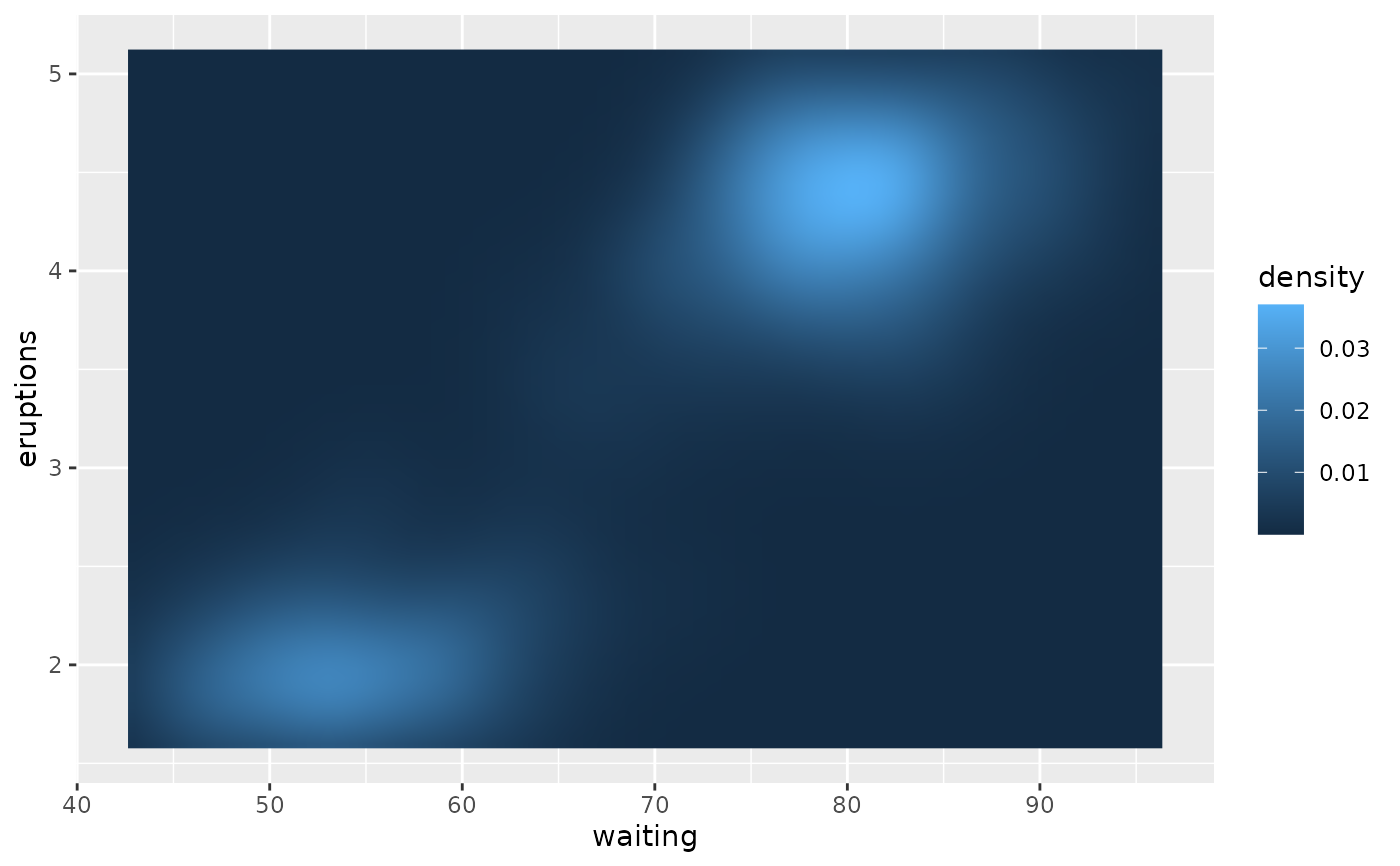 # If you want to draw arbitrary rectangles, use geom_tile() or geom_rect()
df <- data.frame(
x = rep(c(2, 5, 7, 9, 12), 2),
y = rep(c(1, 2), each = 5),
z = factor(rep(1:5, each = 2)),
w = rep(diff(c(0, 4, 6, 8, 10, 14)), 2)
)
ggplot(df, aes(x, y)) +
geom_tile(aes(fill = z), colour = "grey50")
# If you want to draw arbitrary rectangles, use geom_tile() or geom_rect()
df <- data.frame(
x = rep(c(2, 5, 7, 9, 12), 2),
y = rep(c(1, 2), each = 5),
z = factor(rep(1:5, each = 2)),
w = rep(diff(c(0, 4, 6, 8, 10, 14)), 2)
)
ggplot(df, aes(x, y)) +
geom_tile(aes(fill = z), colour = "grey50")
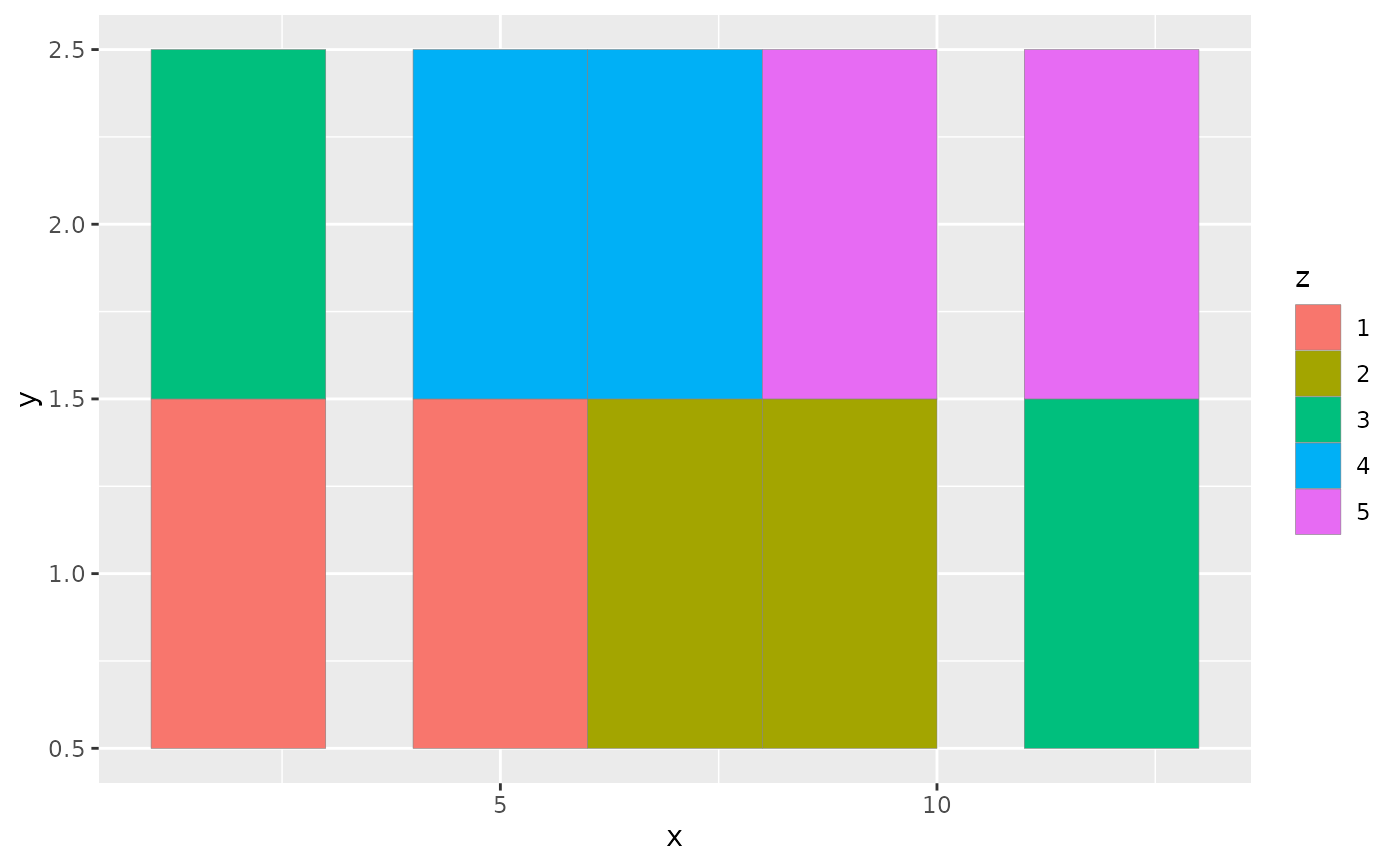 ggplot(df, aes(x, y, width = w)) +
geom_tile(aes(fill = z), colour = "grey50")
ggplot(df, aes(x, y, width = w)) +
geom_tile(aes(fill = z), colour = "grey50")
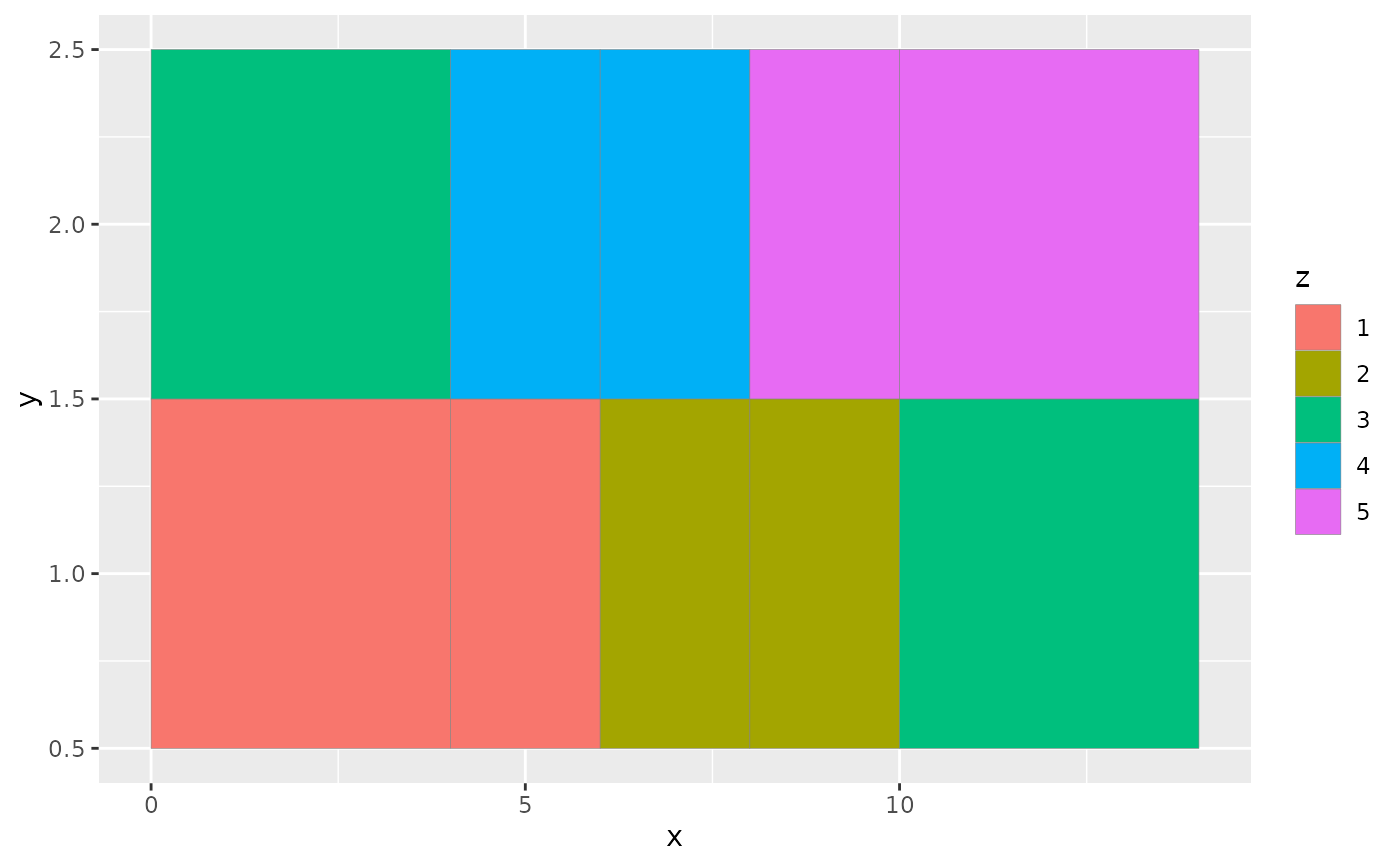 ggplot(df, aes(xmin = x - w / 2, xmax = x + w / 2, ymin = y, ymax = y + 1)) +
geom_rect(aes(fill = z), colour = "grey50")
ggplot(df, aes(xmin = x - w / 2, xmax = x + w / 2, ymin = y, ymax = y + 1)) +
geom_rect(aes(fill = z), colour = "grey50")
 # \donttest{
# Justification controls where the cells are anchored
df <- expand.grid(x = 0:5, y = 0:5)
set.seed(1)
df$z <- runif(nrow(df))
# default is compatible with geom_tile()
ggplot(df, aes(x, y, fill = z)) +
geom_raster()
# \donttest{
# Justification controls where the cells are anchored
df <- expand.grid(x = 0:5, y = 0:5)
set.seed(1)
df$z <- runif(nrow(df))
# default is compatible with geom_tile()
ggplot(df, aes(x, y, fill = z)) +
geom_raster()
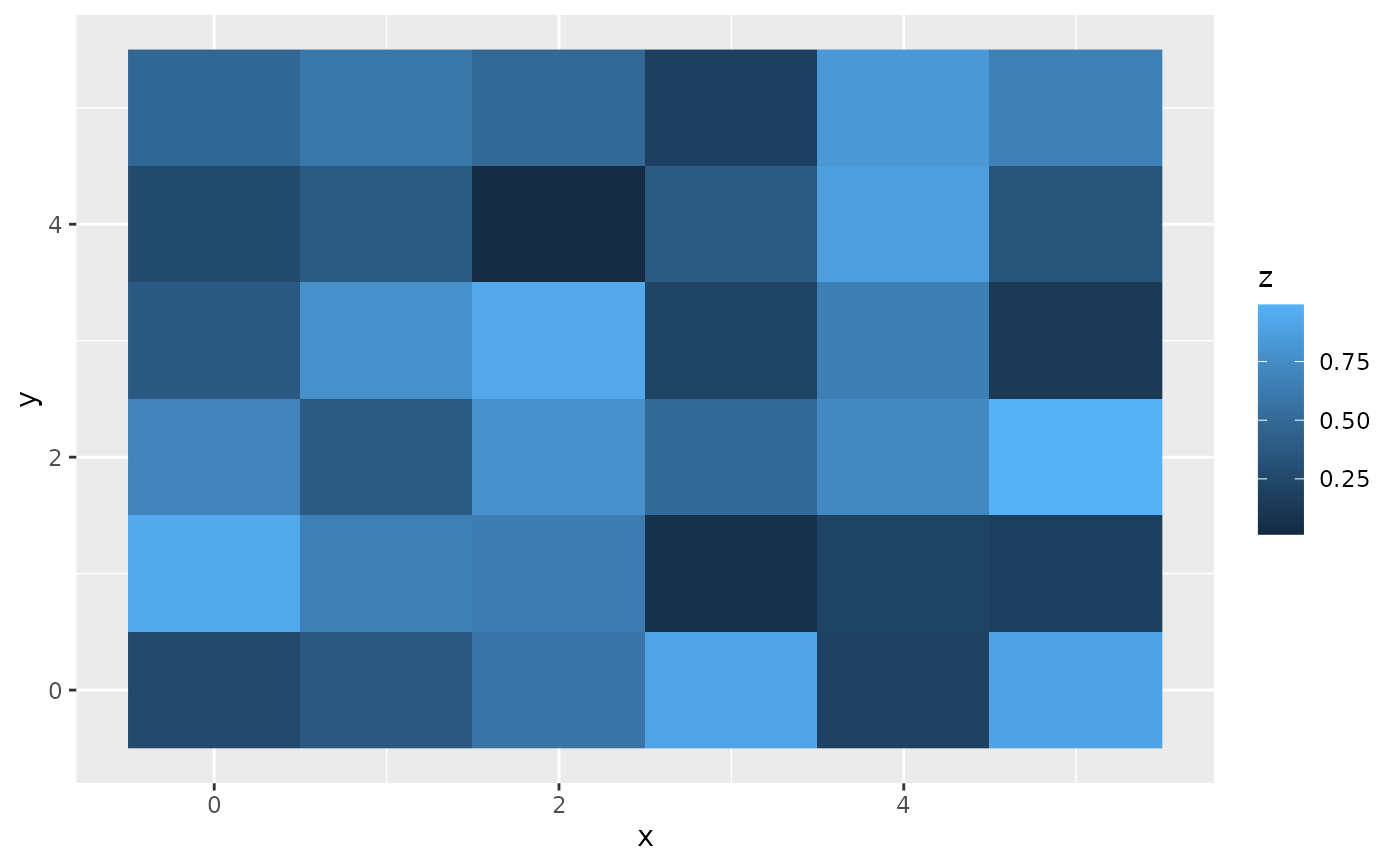 # zero padding
ggplot(df, aes(x, y, fill = z)) +
geom_raster(hjust = 0, vjust = 0)
# zero padding
ggplot(df, aes(x, y, fill = z)) +
geom_raster(hjust = 0, vjust = 0)
 # Inspired by the image-density plots of Ken Knoblauch
cars <- ggplot(mtcars, aes(mpg, factor(cyl)))
cars + geom_point()
# Inspired by the image-density plots of Ken Knoblauch
cars <- ggplot(mtcars, aes(mpg, factor(cyl)))
cars + geom_point()
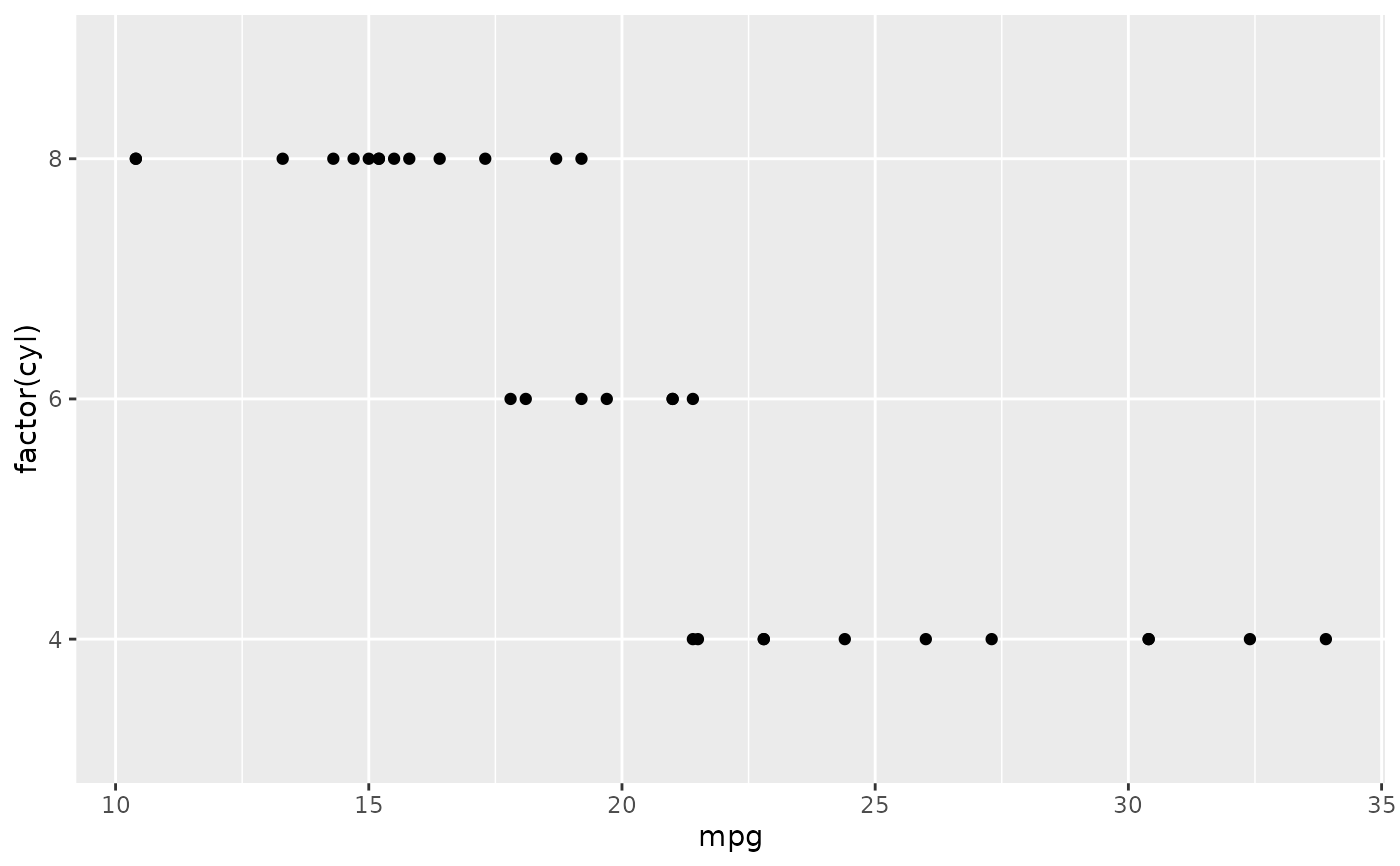 cars + stat_bin_2d(aes(fill = after_stat(count)), binwidth = c(3,1))
cars + stat_bin_2d(aes(fill = after_stat(count)), binwidth = c(3,1))
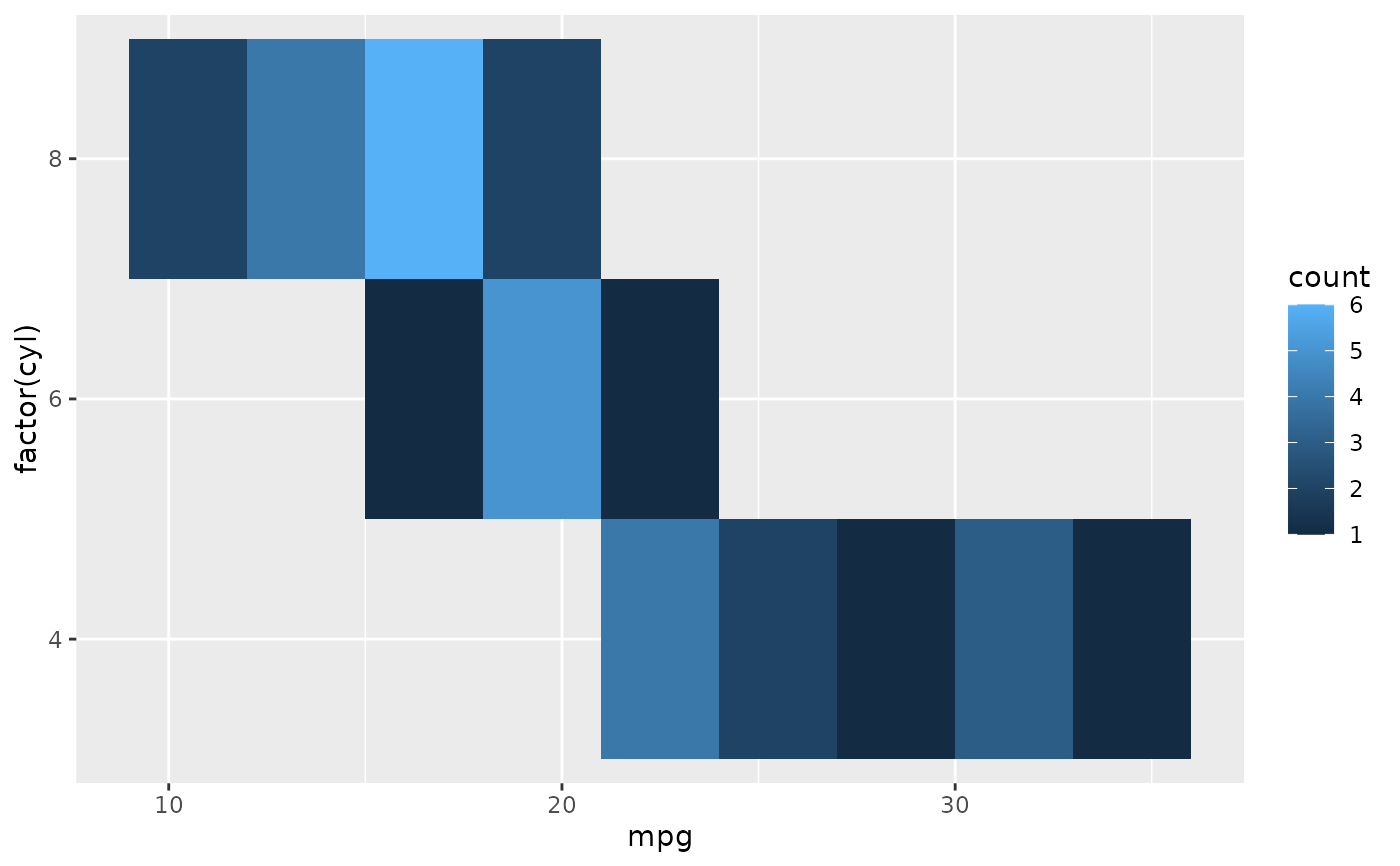 cars + stat_bin_2d(aes(fill = after_stat(density)), binwidth = c(3,1))
cars + stat_bin_2d(aes(fill = after_stat(density)), binwidth = c(3,1))
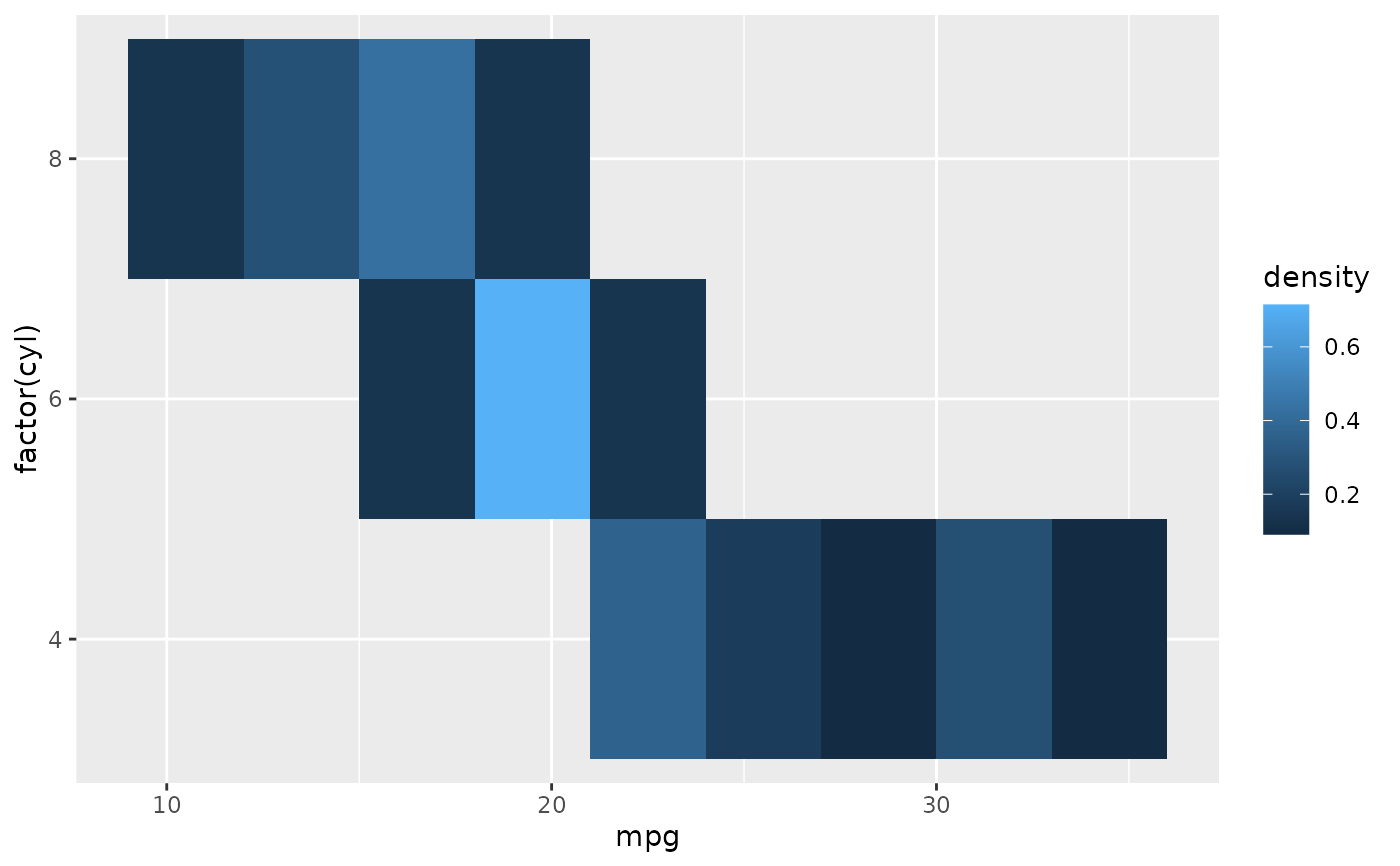 cars +
stat_density(
aes(fill = after_stat(density)),
geom = "raster",
position = "identity"
)
cars +
stat_density(
aes(fill = after_stat(density)),
geom = "raster",
position = "identity"
)
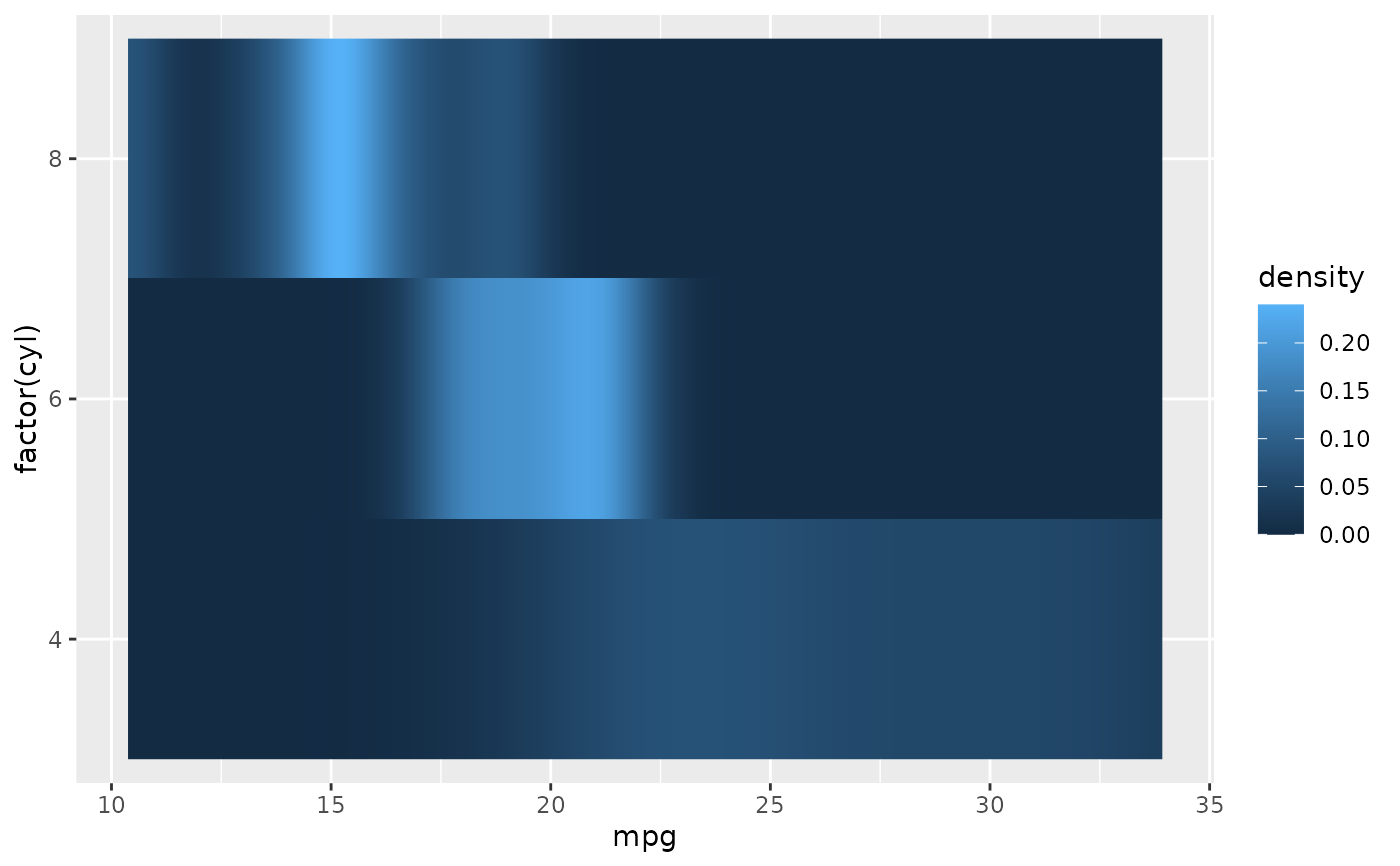 cars +
stat_density(
aes(fill = after_stat(count)),
geom = "raster",
position = "identity"
)
cars +
stat_density(
aes(fill = after_stat(count)),
geom = "raster",
position = "identity"
)
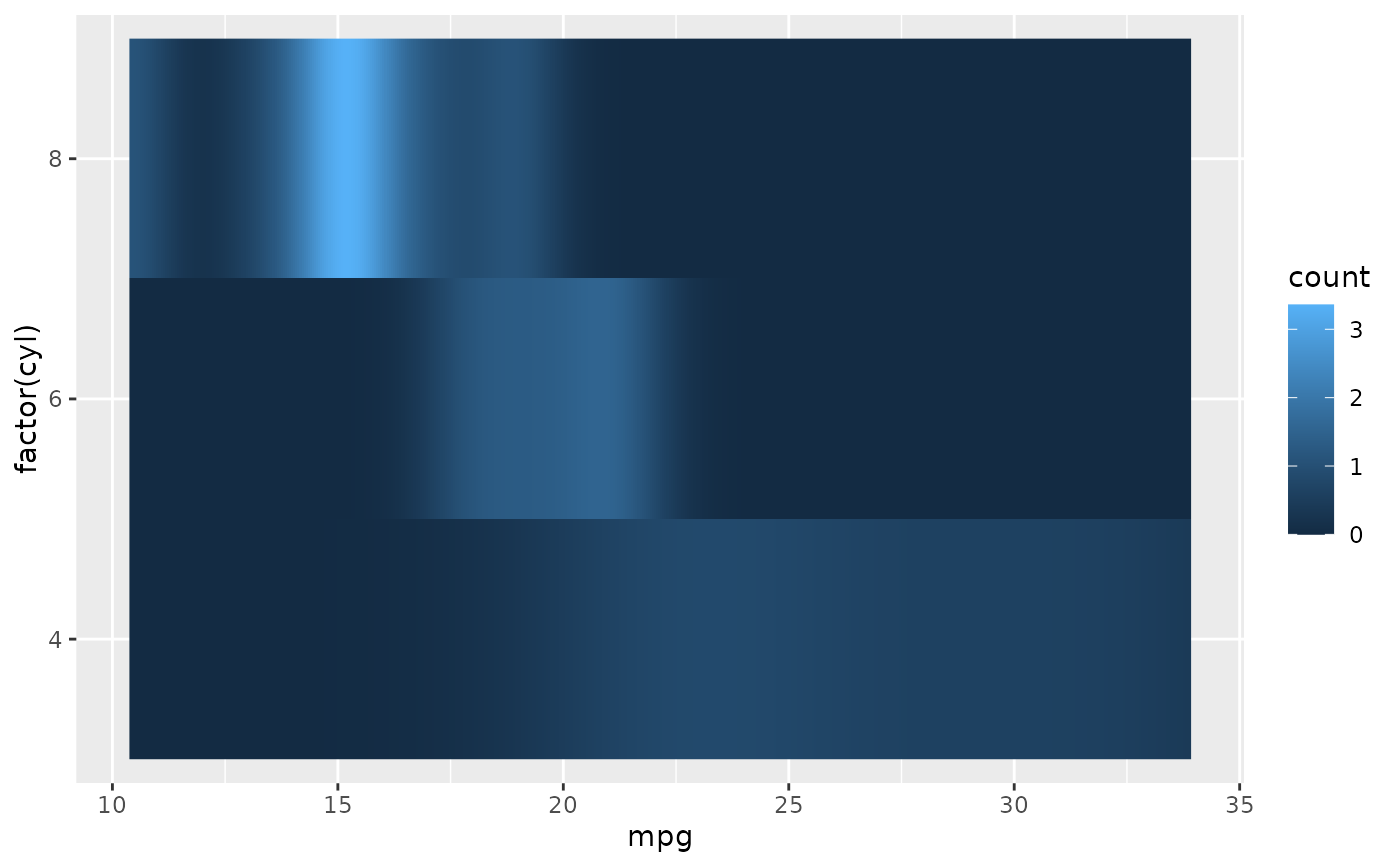 # }
# }
